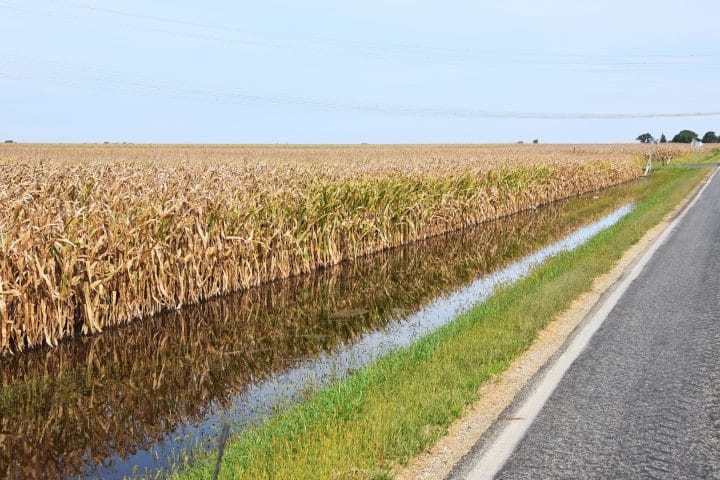Biomass is one of the more controversial renewable energy sources. Whilst it is considered carbon-neutral, it still emits pollution into the atmosphere. But what effect does it have on water? Can biomass energy help to improve water quality?
The short answer is yes it can, however, there are some caveats to this as biomass energy also has the potential to reduce water quality. Let’s start by looking at how biomass improves water quality.
How Biomass Can Improve Water Quality
Biomass energy uses organic matter as its fuel source. This can include everything from wood through to starchy food crops and animal or human waste products. You can even use garden waste to produce biogas inside an anaerobic digester.
Whether or not biomass energy can improve water quality all depends on the type of biomass it uses. Tree crops such as willow, switchgrass, and poplar can help to improve water quality. In contrast, traditional food crops such as corn and wheat can have negative effects on water quality.
Below you will find some of the ways that biomass energy can help to improve water quality. Some of these have conditions attached which are explained in further detail.
By Reducing Harmful Farming Activities
In farming, the idea behind biomass energy improving water quality assumes that traditional food crops are replaced for bioenergy wood crops. This reduces the impact that some food crops (such as corn and wheat) can have on local watercourses.
Replacing food crops for wood crops can help to reduce farming practices that are harmful to the environment. Some of the advantages that wood crops have over food crops include the following:
- Reduced Fertilizer Usage – Food crops (such as corn and wheat) require lots of nutrients to help them grow. This leads to farmers depositing fertilizer rich in Nitrogen and Phosphorous onto their land. Over time, this can seep into local watercourses, polluting the water. In contrast, tree crops (such as willow, switchgrass, and poplar) are able to grow in poorer soil and therefore do not require as much fertilizer.
- Reduced Soil Erosion – The issue of soil erosion affects agriculture in many different ways. When it comes to bioenergy food crops, the problem is exacerbated. Such crops often require tillage (cultivating) to remove row crop residue prior to replanting each year. This can lead to soil detachment, movement, and deposition in watercourses. In contrast, wood crops such as willow are perennials and will grow back many times before replanting is required. As a result, soil erosion is reduced.

It should be noted that many farmers care about the environment and take steps to reduce the effect their operations have on local watercourses. Whatsmore, by taking care of their land, they help to increase the sustainability of their business.
By Reducing Sewage
Whilst most countries treat sewage to remove harmful bacteria and pollution, other’s don’t. This can end up being deposited into rivers, lakes, and even the ocean. By using animal and human waste products to create biogas, we reduce the potential for sewage to seep into our water.
How Biomass Might Actually Reduce Water Quality
Let’s now take a look at the different ways biomass energy can actually reduce water quality.
Through Fertilizers and Soil Erosion
We’ve already touched on how some biomass crops are actually bad for water quality. This mainly revolves around fertilizer use and soil erosion in agriculture.
In the Gulf of Mexico just off the coast of Louisianna and Texas, there is a cyclical event known as the ‘Dead Zone’. Here, the ocean is deprived of Oxygen and sees an annual burst of algae growth which eventually decomposes.
This year’s 8,000 mile-long dead zone has been caused by record-breaking rainfall in the Midwest of the United States. The rain has washed tons of fertilizer rich in Nitrogen and Phosphorous off fields and into streams. This water has then made its way into the Mississippi River before finally emptying into the Gulf of Mexico.
The Dead Zone highlights the wider impact that fertilizer usage and soil erosion can have on water quality.
Biomass Energy Emissions
Some forms of biomass energy burn wood as its fuel source. During combustion, wood releases various gases into the atmosphere. You might not think that these emissions can affect water quality, but you could be wrong.
According to the United States Environmental Protection Agency (EPA), research suggests that air pollution may affect ecosystems. They say that this may lead to the following:
- Excess amounts of acid in lakes and streams.
- Nitrogen being deposited on surface water.
- Mercury being deposited on surface water.
All of the above have the potential to not only reduce water quality but also affect fish and other aquatic life. In addition, when Mercury is consumed by plants and animals, it can enter the food chain, eventually being consumed by people.
Conclusion
As you can see from the information above, there are arguments for and against whether biomass energy can improve water quality.
On the one hand, willow and poplar bioenergy crops can reduce fertilizer use and soil erosion. This can result in improvements to the quality of local watercourses. On the other hand, some bioenergy crops such as corn and wheat can actually reduce water quality by having the opposite effect.
The combustion of biomass energy sources should also be considered. There is growing evidence to suggest that air quality can have an impact on water quality.